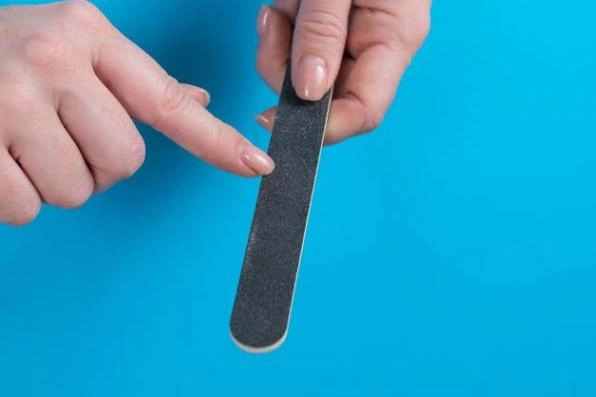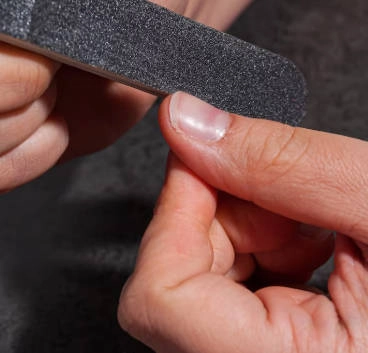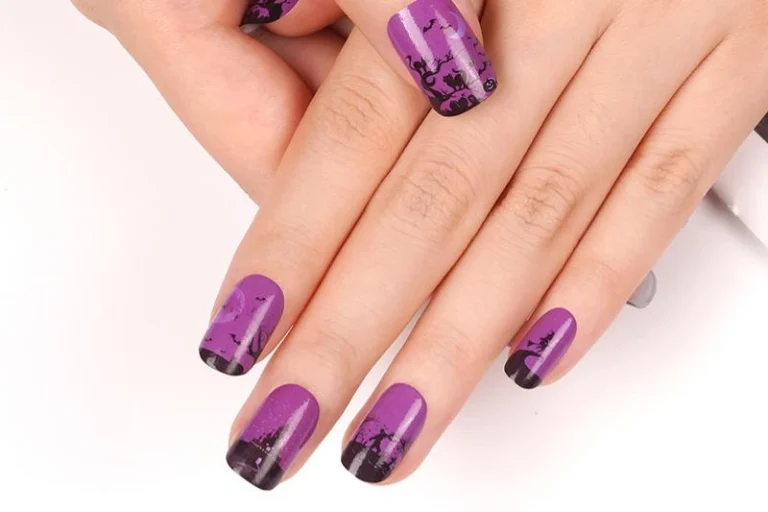Whether you’re a salon pro or a home nail fan, a sandpaper nail file is a must-have in your nail care set. These basic tools look plain. Yet they vary a lot in materials, grits, and shapes. That affects how well they work.

Many think “all nail files are alike.” But picking the right one can mean healthy nails or hurt, over-filed ones. Things like grit number, file material, and shape decide if the file fits natural nails or fake ones.
In this full guide, we cover all you need to know about sandpaper nail files. We explain grit levels. We show differences between files and buffers. We talk about shape roles. We discuss material quality. We cover cleaning steps. And we tell when to swap your file.
What Is Grit, and What Does It Mean?
Grit means the size of rough bits on the file surface. The grit number shows how rough or smooth the file is. Low numbers (like 100 grit) are rough. They take off material fast. High numbers (like 240 grit) are smooth. They work for polishing and finishing.
Double-grit files have two grit levels on each side. Examples include 100/180 or 180/240. They give more options in one tool. For instance:
- 100 grit works great to cut length on acrylic or gel tips.
- 180 grit fits soft gel layers or pre-buffing.
- 240 grit is safe for shaping real nails. It avoids harm.
A simple tip: rough grits shape and remove bulk. Fine grits finish and smooth.
Sandpaper Nail Files vs Buffers
Sandpaper nail files have a stiff core. It is often plastic or foam. Rough paper covers one or both sides. Buffers have a soft, sponge core. A finer rough material covers it.
Even with the same grit (say 180), they act differently. Flexibility and base material change performance. Files give exact control and firmness for shaping. Buffers shine at surface smoothing and gloss.
Use files for:
- Cutting length
- Setting shape
- Handling add-ons
Use buffers for:
- Prepping real nails before color or wraps
- Fixing surface flaws
- Final gloss polish
Pro tip: High-gloss buffers cut product stickiness. Skip them before gel polish or wraps.
Nail File Shapes and Their Functions
Straight
This standard shape gives exact control. It works well on nail side walls. It suits square or coffin shapes with sharp edges.
Oval
Oval files have rounded tips. They feel comfy near the cuticle. They stop accidental cuts or too much filing in tender spots.
Banana
Banana files have a natural bend. They reach around the cuticle zone with ease. Your wrist stays relaxed. They suit long filing times.
Half-Moon
This mix shape joins straight edges for shaping with curved sides for detail. Pros like it as an all-in-one tool.
Types of Sandpaper Nail Files & Which Grit to Choose
Sandpaper Nail Files (100–240 grit)
Felice beauty sells pro-level sandpaper nail files in many grits:
- 100 grit – Extra rough. It shortens hard gels and acrylic tips fast.
- 150 grit – Good for shaping thick layers. Not too harsh.
- 180 grit – Perfect for finishing gel polish layers or prepping real nails.
- 240 grit – Soft enough for real nails. Great for smoothing and final shaping.
All items can be made to order. Pre-production samples are ready for quality checks before big orders.
Buffer Blocks & Sponge Buffers (180–12,000 grit)
Felice beauty also makes sponge buffers like:
- 180 buffer – For finishing gel polish or layer surfaces.
- 240 buffer – Preps real nails for color or wraps.
- 2,400–12,000 high-grit buffers – Give high-gloss shine on bare nails.
High-quality sponge nail file buffers with custom logo blocks allow logo options and pro strength.
Key Tip: Skip high-gloss buffers before gels or stickers. They hurt stickiness.
Practical Tip Box
New sandpaper files often have sharp sides. Use an old file to dull the edges before real nail contact.
Does the Quality of a Sandpaper Nail File Matter?
Yes. Here’s why:
Abrasive Quality
Even grit gives steady filing. No tears or scratches. Low-cost files may have uneven bits. They harm the nail top.
Paper & Coating Quality
Top-grade rough paper lasts longer. It fights dust clogs. Premium layers stop buildup. They boost strength in busy salon use.
Adhesive Layer
Strong glue holds rough parts to the core. Weak glue leads to peeling paper or loose bits. Those scratch nails.
Why Quality Saves Money
Low-cost nail files wear quick. They need more push. They tire hands. Felice beauty’s Professional high quality custom private logo zebra grey nail file and emery board gives cleaner work with less work. They cost less over time.
How to Clean and Sanitize Sandpaper Nail Files
Good cleaning matters a lot. This is key in pro spots. Follow these steps:
- Brush off all seen dust with a dry brush.
- Wash with warm soapy water for 2–3 minutes.
- Rinse well under clean water.
- Towel-dry or air-dry fully.
- Spray with a disinfectant (any brand).
- Let it dry completely before storage.
- Keep in a clean pouch to avoid dirt.
For salons: Use one file per client if you reuse.
Do Sandpaper Nail Files Need Replacing?
Sandpaper nail files do not last forever. They wear out.
Swap your file if:
- It gets body fluids on it.
- The grit feels flat or weak.
- You must push harder to work.
A good file glides easy. It does the job with little push.

Picking the right sandpaper nail file means more than grabbing any emery board. Know grit sizes. Choose good materials. Pick the shape for your needs. Keep hygiene. Know when to replace tools. These steps lead to perfect nails at home or in a salon.
Choose Felice beauty. It means you pick a pro and trusted partner. With a full line of custom sandpaper nail files and buffers for pros and fans, Felice beauty gives top tools. We bring great results each time.
FAQ
Q: What grit sandpaper nail file should I use for natural nails?
A: For real nails, choose 180–240 grit sandpaper nail files. They shape and smooth without harm.
Q: How do sandpaper nail files differ from sponge buffers?
A: Sandpaper nail files have a stiff core for exact shaping. Sponge buffers are soft for surface smoothing and shine.
Q: Can sandpaper nail files be cleaned and reused?
A: Yes. Brush off dust. Wash with soapy water. Rinse. Disinfect. Air-dry sandpaper nail files for safe reuse.
Q: When should I replace my sandpaper nail file?
A: Swap your sandpaper nail file when the grit feels flat. Or it needs extra push. Or it shows wear.





